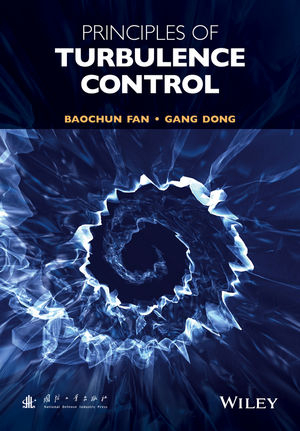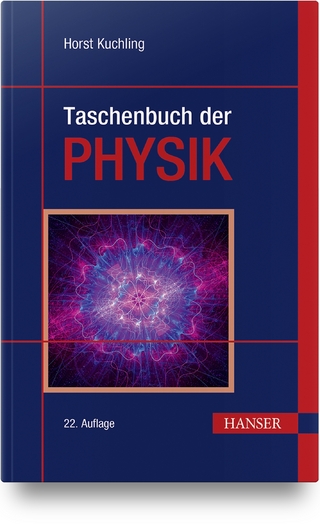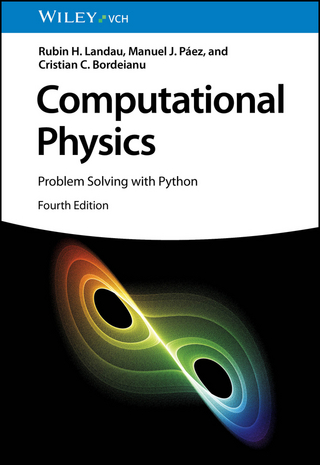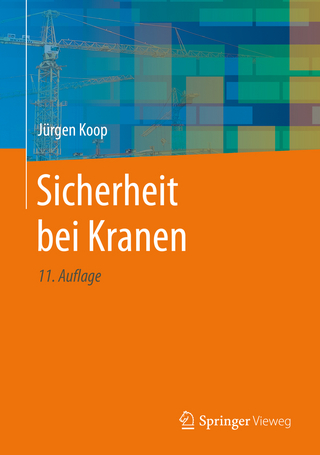
Principles of Turbulence Control
John Wiley & Sons Inc (Verlag)
978-1-118-71801-8 (ISBN)
Dr. Baochun Fan, Chair Professor of the State Key Laboratory of Transient Physics, Nanjing University of Science and Technology, China. Professor Fan obtained his Ph.D. degree from Nanjing University of Science and Technology, China, in 1982 and during his career has been a visiting professor at Michigan University, USA, University of Technology, Aachen, Germany, and University of Connecticut, USA. His areas of expertise include theoretical, numerical and experimental fluid mechanics, flow control, combustion and detonation, and protection from fire and explosion. From 200 to 2004, he was the Chair of Detonation Committee of Chinese Society of Mechanics. He is currently a Member of the Editorial Board of Journal of Ballistics (in Chinese). He has authored four books in Chinese, and published over 100 journal papers in the past 10 years.
About the Authors ix
Preface xi
Part I WALL TURBULENCE
1 Statistical Analysis and Spectral Method 3
1.1 Statistical Analysis and Spectral Method 3
1.1.1 Average Value 3
1.1.2 Probability Density and Statistical Moments 5
1.1.3 Correlation Function 9
1.2 Statistical Analysis of Turbulence 11
1.2.1 Reynolds Stress and Turbulent Kinetic Energy 11
1.2.2 Variable-Interval Time Average Method 13
1.3 Fourier Transform and Spectrum 16
1.3.1 Harmonic Wave 16
1.3.2 Fourier Transform 18
1.3.3 Energy Spectrum 22
1.4 Spectral Series Expansion of Function 22
1.4.1 Orthogonal Basis 22
1.4.2 Fourier Series 23
1.4.3 Chebyshev Polynomials 24
1.5 Fundamentals of Spectral Methods 26
1.5.1 Fundamental Concepts 26
1.5.2 Fourier–Galerkin Method 29
1.5.3 Chebyshev–Tau Method 31
1.5.4 Helmholtz Equation 34
1.6 Spectral Method of Navier–Stokes Equations 38
1.6.1 Time Integration Method 38
1.6.2 Spectral Method based on Time Marching Algorithms (1) 41
1.6.3 Spectral Method based on Time Marching Algorithms (2) 50
1.6.4 Spectral Method based on Time-Split Method 52
1.7 Closed Remarks 54
References 55
2 Wall Turbulence and Its Coherent Structure 57
2.1 Boundary Layer Flow and Flow Stability 58
2.1.1 Boundary Layer Flow 58
2.1.2 Flow Stability 59
2.1.3 Linear Stability Theory of Flow 61
2.2 Transition of Boundary Layer Flow 63
2.2.1 Basic Process 63
2.2.2 Receptivity Stage 64
2.2.3 Linear Instability and Transient Growth 68
2.2.4 Nonlinear Instability and Turbulent Spot 71
2.2.5 Bypass Transition 75
2.3 Coherent Structure of Wall Turbulence 77
2.3.1 Statistical Properties of Near-Wall Turbulence 78
2.3.2 Structural Features and Identification of Streak 82
2.3.3 Structural Features and Identification of Vortex 83
2.4 Formation and Evolution of a Coherent Structure 89
2.4.1 Formation and Instability of Streak 89
2.4.2 Formation of a Vortex Structure 92
2.4.3 A Novel Coherent Motion: Soliton and Its Relevant Structures 97
2.5 Bursting and Self-Sustaining of Wall Turbulence 102
2.5.1 Bursting Event 103
2.5.2 Self-Sustaining of a Coherent Structure 105
2.6 Closed Remarks 107
References 109
Part II CONTROL OF WALL TURBULENCE
3 Control of Turbulence with Active Wall Motion 115
3.1 Stokes Second Problem 118
3.2 Experiments of Wall Turbulence with Spanwise Wall Oscillation 121
3.2.1 Incompressible Flow with Spanwise Wall Oscillation 121
3.2.2 Compressible Flow with Spanwise Wall Oscillation 127
3.3 Numerical Simulation of Wall Turbulence with Spanwise Wall Oscillation 136
3.3.1 Wall Turblence with Spanwise Wall Oscillation 136
3.3.2 Control Mechanism of Spanwise Wall Oscillation 139
3.3.3 Wall Turbulence with Spanwise Traveling Wave on Wavy Wall 147
3.3.4 Wall Turbulence with Streamwise Traveling Wave on Wavy Wall 150
3.4 Deformed Wall 153
3.4.1 Shape Memory Alloy 155
3.4.2 Piezoceramics 156
3.4.3 Magnet 157
3.4.4 Cam Mechanism 158
3.5 Experiments of Wall Turbulence with Deformed Wall 158
3.5.1 Incompressible Flow with Deformed Wall 158
3.5.2 Compressible Flow with Deformed Wall 160
3.6 Numerical Simulation of Wall Turbulence with Deformed Wall 164
3.6.1 Wall Turbulence with Streamwise-Traveling Surface Deformation Wave 164
3.6.2 Wall Turbulence with Sinusoidally Deformed Wall 173
3.6.3 Wall Turbulence with Opposition Wall Deformation Control 177
3.6.4 Control Mechanism of Deformed Wall 188
3.7 Closed Remarks 192
References 193
4 Control of Turbulence by Lorentz Force 195
4.1 Lorentz Force 197
4.2 Experiments of Wall Turbulence with Spanwise Lorentz Force 200
4.2.1 Control with Uniform Spanwise Oscillating Lorentz Force 200
4.2.2 Control with Wavy Lorentz Force 206
4.3 Numerical Simulation of Wall Turbulence with Spanwise Lorentz Force 214
4.3.1 Spanwise Lorentz Force 214
4.3.2 Generalized Stokes Layer Induced by Oscillating Lorentz Force 216
4.3.3 Control with Spanwise Oscillating Lorentz Force 219
4.3.4 Control with Wavy Lorentz Force 239
4.4 Wall Turbulence with Wall-Normal Lorentz Force 260
4.4.1 Three-Dimensional Lorentz Force Field 260
4.4.2 Experiments on Wall Normal EM Actuator Tile 261
4.4.3 Numerical Simulation of Wall Turbulence with Normal Lorentz Force 263
4.5 Closed Remarks 265
References 267
Part III OPTIMAL FLOW CONTROL
5 Linear Optimal Flow Control 271
5.1 Optimal Control 273
5.1.1 Introduction 273
5.1.2 Optimal Control for Ordinary Differential Equations 277
5.2 Optimal Control of Linear Quadratic Systems 280
5.2.1 Linear Quadratic Optimal Control 280
5.2.2 Discrete Linear Quadratic Systems 287
5.2.3 Linear Quadratic Gaussian (LQG) Control in the Presence of Noise 288
5.3 Linear Process in Near-Wall Turbulent Flow 290
5.4 Linear Optimal Control of Two-Dimensional Flow 294
5.4.1 Linearization of Navier–Stokes Equations 294
5.4.2 Spectral Decomposition of Linearized Flow 296
5.4.3 Standard State-Space Representations of Linearized Flow 299
5.4.4 Linear Optimal Control of Channel Flow 302
5.5 Linear Optimal Control of Three-Dimensional Flow 305
5.6 Closed Remarks 309
References 310
6 Nonlinear Optimal Flow Control 313
6.1 Fundamentals of Optimal Flow Control 314
6.1.1 Closed-Loop Flow Control 314
6.1.2 Cost Functional 315
6.1.3 Fréchet Differential 316
6.2 Spectrum-based Suboptimal Control 316
6.2.1 Control of Channel Flow 316
6.2.2 Control of Backward-Facing Step Flow 323
6.2.3 Control of Cylinder Flow 329
6.3 Adjoint-based Suboptimal Control 341
6.3.1 Fundamentals of Adjoint-based Suboptimal Control 341
6.3.2 Adjoint-based Suboptimal Control 344
6.3.3 Near-Wall Turbulence Controlled by Blowing–Suction Wall 347
6.3.4 Cylinder Flow Controlled by Lorentz Force 348
6.4 Neural Network in Flow Control 360
6.4.1 Neural Network 360
6.4.2 Near-Wall Turbulence Controlled by Blowing–Suction Wall 361
6.4.3 Near-Wall Turbulence Controlled by Deformed Wall 367
6.4.4 Near-Wall Turbulence Controlled by Lorentz Force 370
6.5 Closed Remarks 372
References 373
Index 375
| Verlagsort | New York |
|---|---|
| Sprache | englisch |
| Maße | 170 x 244 mm |
| Gewicht | 748 g |
| Themenwelt | Naturwissenschaften ► Physik / Astronomie |
| Technik ► Maschinenbau | |
| ISBN-10 | 1-118-71801-1 / 1118718011 |
| ISBN-13 | 978-1-118-71801-8 / 9781118718018 |
| Zustand | Neuware |
| Informationen gemäß Produktsicherheitsverordnung (GPSR) | |
| Haben Sie eine Frage zum Produkt? |
aus dem Bereich


